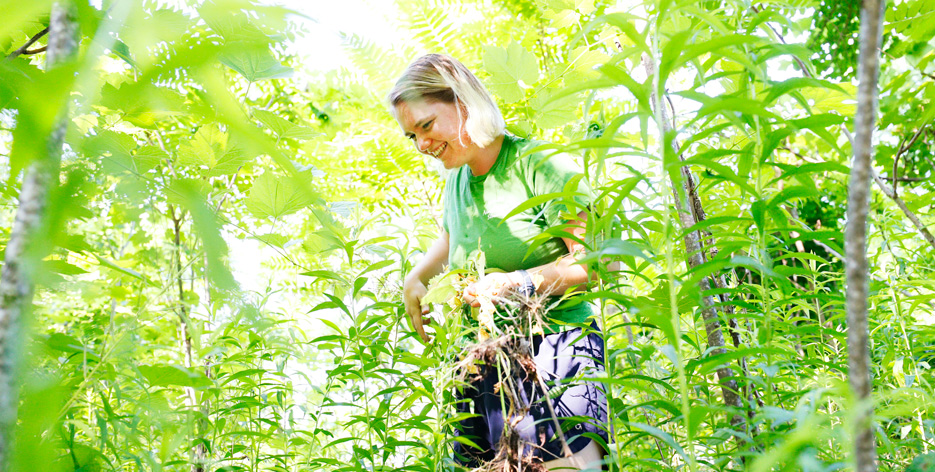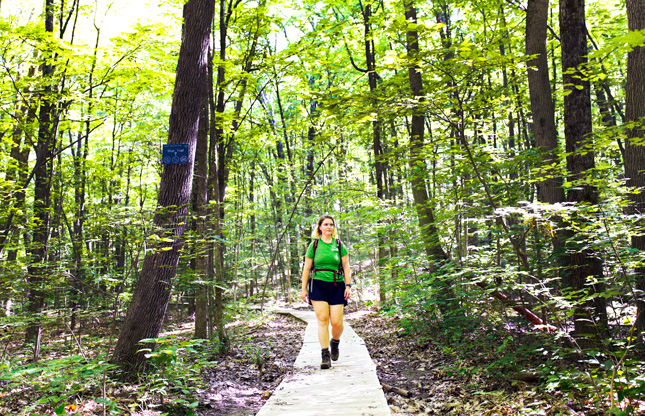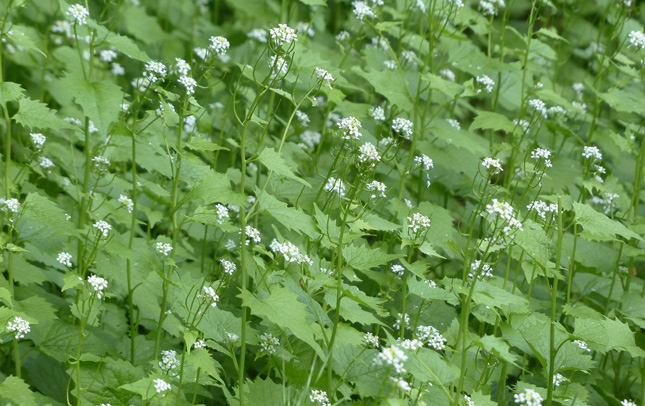A recipe for the battle against garlic mustard

My name is Stella Piasecki ’23. I’m an environmental studies major from Great Barrington, Massachusetts, and I’ve dedicated a decade of my life to the
battle against a destructive, distressing and downright deplorable entity — garlic
mustard.
I like to think of myself as a garlic mustard warrior, and this summer I am continuing
my campaign here at Skidmore. How does one get drafted for this duty? It starts with
a deep love for the outdoors.
Growing up in the Berkshires, I've always had a deep love for forests. When I was
choosing a college, I knew it had to be one that had a forest readily available for
my exploration.
When I arrived at Skidmore following a pre-orientation trip, one of the first things I did was look up a map of campus and head in the direction
of the North Woods.
On that first day, walking the red trail loop, I got a small taste of what these beautiful
155 acres of preserved land have to offer. I knew I was in love, and the North Woods
made me feel right at home.
In my time at Skidmore since that first walk, I’ve often returned to the woods for
some respite and exercise and to explore and learn. But each time I visited, I noticed
that invasive species like garlic mustard had taken root. I knew I had to find a way
to get involved, and I found the perfect opportunity — working as a North Woods steward.

North Woods stewards are student employees who work for Skidmore’s Sustainability Office over the summer and throughout the school year to help preserve, protect and raise
awareness around this treasured campus resource. The woods are connected to campus
with five hiking trails, which lead visitors through nature and away from the hustle
and bustle of everyday life. In addition to offering recreational opportunities, the
woods are also used by professors in classes and other projects, including summer collaborative research with students.
Stewards do everything from conducting trail maintenance to improving wayfinding with
signage and kiosks. The whole job is very rewarding, but I feel the most joy when
I know I’m helping to maintain the woods for future generations by pulling and disposing
of invasive species.
In just three weeks on the job, I’ve pulled tens of thousands of garlic mustard plants. The North Woods Stewardship has given me the opportunity to devote the majority of my summer to doing what I love: protecting the natural beauty of native forests.
Why start a war with garlic mustard?
Throughout my life, I have been devoted to reducing populations of garlic mustard, both in Massachusetts and here at Skidmore. One single plant can produce hundreds of microscopic seeds that can sit in the soil for years and create hard-to-fight patches that displace native plants like wildflowers and tree seedlings.
Garlic mustard is particularly troublesome because it grows in thick outcrops that choke out anything else nearby. The roots of garlic mustard also produce a toxin that kills soil fungi that many plants depend on.
Basically, garlic mustard is the worst in all possible ways.
If left unmanaged, invasive species like garlic mustard can reduce the biodiversity
of an ecosystem by outcompeting native species and reducing resources for native flora
and fauna.
To pull garlic mustard effectively, you need to pull the entire plant, including its
root system. It is really important to dispose of garlic mustard properly because
if you leave the plants after you have pulled them, they can easily regrow in the
area where they are left. We bag up the plants in trash bags, seal the bags and then
throw them out as, well, trash.

Garlic mustard, originally from Europe and Asia, has become a very troublesome invasive plant across the Northeast, Midwest and Northwest of the United States.
While I'm determined to destroy the garlic mustard and save the North Woods, I also
struggle to see enormous piles of wasted plant material. I'm excited to share that
there’s a silver lining to such a dark and devious plant: Its leaves are completely
edible.
I have been making garlic mustard pesto every summer since I was 10 years old, and
it has become one of my favorite summer traditions.
Now, it is my honor to recruit you in the campaign against garlic mustard with this recipe:
Garlic Mustard Pesto Recipe
Ingredients
- 2-5 cups young garlic mustard leaves
- 2-3 cloves of garlic
- 1 small bunch of basil
- 1 teaspoon Tofutti cream cheese (or your choice of dairy Parmesan or regular cream cheese)
- 2-3 tablespoons extra-virgin olive oil
- 1/2 cup bean sprouts
- 3 pinches pepper
- Salt to taste
Equipment
- Food processor
- Rubber spatula
- Salad spinner
Directions
- Remove healthy looking leaves from the garlic mustard stalk until you have 2-5 cups of healthy leaves.
- Place the leaves in a salad spinner and rinse thoroughly. Let drain for two minutes and then rinse again. Repeat this process two more times for a total of four rinses then spin the salad spinner for a few minutes to get the leaves very dry.
- Once the leaves are dry, place them in the food processor.
- Add olive oil, pepper, garlic and basil then turn the food processor on high for 30-50 seconds or until it is pretty finely ground.
- Add cream cheese and a few pinches of salt.
- Turn the food processor back on until cream cheese has been thoroughly mixed in.
- Salt to taste.
- Use a rubber spatula to stir the pesto making sure everything is finely ground and mixed in, then use the spatula to transfer pesto into a container of your choice.
- Sprinkle bean sprouts on top.
- Enjoy!
